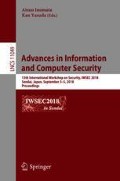Abstract
Side Channel Attacks are an important attack vector on secure AES implementations. The Correlation-Enhanced Power Analysis Collision Attack by Moradi et al. [MME10] is a powerful collision attack that exploits leakage caused by collisions in between S-Box computations of AES. The attack yields observations from which the AES key can be inferred. Due to noise, an insufficient number of collisions, or errors in the measurement setup, the attack does not find the correct AES key uniquely in practice, and it is unclear how to determine the key in such a scenario. Based on a theoretical analysis on how to quantify the remaining entropy, we derive a practical search algorithm. Both our theoretical analysis and practical experiments show that even in a setting with high noise or few available traces we can either successfully recover the full AES key or reduce its entropy significantly.
Access this chapter
Tax calculation will be finalised at checkout
Purchases are for personal use only
Notes
- 1.
The attack can be extended to other key sizes in a straight-forward manner by targeting a second AES round [MME10].
- 2.
Since one key byte cannot be determined by the algorithm, the accurate remaining entropy is more properly \(\log _2(A_{16})+8\).
- 3.
References
Agrawal, D., Archambeault, B., Rao, J.R., Rohatgi, P.: The EM side—channel(s). In: Kaliski, B.S., Koç, K., Paar, C. (eds.) CHES 2002. LNCS, vol. 2523, pp. 29–45. Springer, Heidelberg (2003). https://doi.org/10.1007/3-540-36400-5_4
Akkar, M.-L., Giraud, C.: An implementation of DES and AES, secure against some attacks. In: Koç, Ç.K., Naccache, D., Paar, C. (eds.) CHES 2001. LNCS, vol. 2162, pp. 309–318. Springer, Heidelberg (2001). https://doi.org/10.1007/3-540-44709-1_26
Brier, E., Clavier, C., Olivier, F.: Correlation power analysis with a leakage model. In: Joye, M., Quisquater, J.-J. (eds.) CHES 2004. LNCS, vol. 3156, pp. 16–29. Springer, Heidelberg (2004). https://doi.org/10.1007/978-3-540-28632-5_2
Bogdanov, A.: Multiple-differential side-channel collision attacks on AES. In: Oswald, E., Rohatgi, P. (eds.) CHES 2008. LNCS, vol. 5154, pp. 30–44. Springer, Heidelberg (2008). https://doi.org/10.1007/978-3-540-85053-3_3
Canright, D.: A very compact S-Box for AES. In: Rao, J.R., Sunar, B. (eds.) CHES 2005. LNCS, vol. 3659, pp. 441–455. Springer, Heidelberg (2005). https://doi.org/10.1007/11545262_32
Canright, D., Batina, L.: A very compact “Perfectly Masked” S-box for AES. In: Bellovin, S.M., Gennaro, R., Keromytis, A., Yung, M. (eds.) ACNS 2008. LNCS, vol. 5037, pp. 446–459. Springer, Heidelberg (2008). https://doi.org/10.1007/978-3-540-68914-0_27
Clavier, C., Feix, B., Gagnerot, G., Roussellet, M., Verneuil, V.: Improved collision-correlation power analysis on first order protected AES. In: Preneel, B., Takagi, T. (eds.) CHES 2011. LNCS, vol. 6917, pp. 49–62. Springer, Heidelberg (2011). https://doi.org/10.1007/978-3-642-23951-9_4
Chari, S., Rao, J.R., Rohatgi, P.: Template attacks. In: Kaliski, B.S., Koç, K., Paar, C. (eds.) CHES 2002. LNCS, vol. 2523, pp. 13–28. Springer, Heidelberg (2003). https://doi.org/10.1007/3-540-36400-5_3
Glowacz, C., Grosso, V., Poussier, R., Schüth, J., Standaert, F.-X.: Simpler and more efficient rank estimation for side-channel security assessment. In: Leander, G. (ed.) FSE 2015. LNCS, vol. 9054, pp. 117–129. Springer, Heidelberg (2015). https://doi.org/10.1007/978-3-662-48116-5_6
Gandolfi, K., Mourtel, C., Olivier, F.: Electromagnetic analysis: concrete results. In: Koç, Ç.K., Naccache, D., Paar, C. (eds.) CHES 2001. LNCS, vol. 2162, pp. 251–261. Springer, Heidelberg (2001). https://doi.org/10.1007/3-540-44709-1_21
Kocher, P., Jaffe, J., Jun, B.: Differential power analysis. In: Wiener, M. (ed.) CRYPTO 1999. LNCS, vol. 1666, pp. 388–397. Springer, Heidelberg (1999). https://doi.org/10.1007/3-540-48405-1_25
Kocher, P.C.: Timing attacks on implementations of Diffie-Hellman, RSA, DSS, and other systems. In: Koblitz, N. (ed.) CRYPTO 1996. LNCS, vol. 1109, pp. 104–113. Springer, Heidelberg (1996). https://doi.org/10.1007/3-540-68697-5_9
Ledig, H., Muller, F., Valette, F.: Enhancing collision attacks. In: Joye, M., Quisquater, J.-J. (eds.) CHES 2004. LNCS, vol. 3156, pp. 176–190. Springer, Heidelberg (2004). https://doi.org/10.1007/978-3-540-28632-5_13
Moradi, A., Mischke, O., Eisenbarth, T.: Correlation-enhanced power analysis collision attack. In: Mangard, S., Standaert, F.-X. (eds.) CHES 2010. LNCS, vol. 6225, pp. 125–139. Springer, Heidelberg (2010). https://doi.org/10.1007/978-3-642-15031-9_9
Martin, D.P., Mather, L., Oswald, E., Stam, M.: Characterisation and estimation of the key rank distribution in the context of side channel evaluations. In: Cheon, J.H., Takagi, T. (eds.) ASIACRYPT 2016. LNCS, vol. 10031, pp. 548–572. Springer, Heidelberg (2016). https://doi.org/10.1007/978-3-662-53887-6_20
Martin, D.P., O’Connell, J.F., Oswald, E., Stam, M.: Counting Keys in Parallel After a Side Channel Attack. In: Iwata, T., Cheon, J.H. (eds.) ASIACRYPT 2015. LNCS, vol. 9453, pp. 313–337. Springer, Heidelberg (2015). https://doi.org/10.1007/978-3-662-48800-3_13
Moradi, A., Standaert, F.: Moments-correlating DPA. In: Proceedings of 2016 TIS SEC Workshop, pp. 5–15 (2016)
National Institute of Standards and Technology: FIPS PUB 197. Advanced Encryption Standard, Technical report (2001)
Quisquater, J.-J., Samyde, D.: ElectroMagnetic Analysis (EMA): measures and counter-measures for smart cards. In: Attali, I., Jensen, T. (eds.) E-smart 2001. LNCS, vol. 2140, pp. 200–210. Springer, Heidelberg (2001). https://doi.org/10.1007/3-540-45418-7_17
Schramm, K., Leander, G., Felke, P., Paar, C.: A collision-attack on AES. In: Joye, M., Quisquater, J.-J. (eds.) CHES 2004. LNCS, vol. 3156, pp. 163–175. Springer, Heidelberg (2004). https://doi.org/10.1007/978-3-540-28632-5_12
Schramm, K., Wollinger, T., Paar, C.: A new class of collision attacks and its application to DES. In: Johansson, T. (ed.) FSE 2003. LNCS, vol. 2887, pp. 206–222. Springer, Heidelberg (2003). https://doi.org/10.1007/978-3-540-39887-5_16
Veyrat-Charvillon, N., Gérard, B., Renauld, M., Standaert, F.-X.: An optimal key enumeration algorithm and its application to side-channel attacks. In: Knudsen, L.R., Wu, H. (eds.) SAC 2012. LNCS, vol. 7707, pp. 390–406. Springer, Heidelberg (2013). https://doi.org/10.1007/978-3-642-35999-6_25
Acknowledgements
We would like to thank Sven Freud for creating the circuit board for power analysis, and Tobias Senger for his help with implementing the masking scheme. We also thank the anonymous reviewers for their helpful comments.
Author information
Authors and Affiliations
Corresponding author
Editor information
Editors and Affiliations
Rights and permissions
Copyright information
© 2018 Springer Nature Switzerland AG
About this paper
Cite this paper
Wiemers, A., Klein, D. (2018). Entropy Reduction for the Correlation-Enhanced Power Analysis Collision Attack. In: Inomata, A., Yasuda, K. (eds) Advances in Information and Computer Security. IWSEC 2018. Lecture Notes in Computer Science(), vol 11049. Springer, Cham. https://doi.org/10.1007/978-3-319-97916-8_4
Download citation
DOI: https://doi.org/10.1007/978-3-319-97916-8_4
Published:
Publisher Name: Springer, Cham
Print ISBN: 978-3-319-97915-1
Online ISBN: 978-3-319-97916-8
eBook Packages: Computer ScienceComputer Science (R0)

